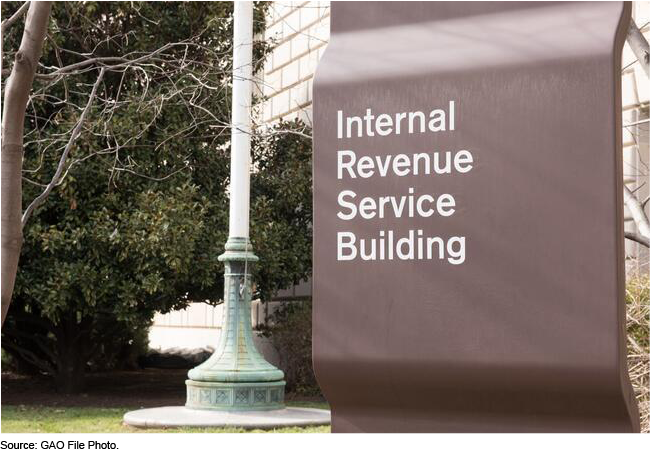Information Technology: Cost and Schedule Performance of Selected IRS Investments
Fast Facts
The IRS reported spending about $2.8 billion in FY 2020 on its IT systems for collecting taxes, distributing refunds, and more.
According to the IRS, the five IT systems in our review met most of the performance goals it had set for FYs 2019 and 2020.
But one of the systems, intended as a replacement for a 60-year-old system, is now on track to replace core functions only—and it may not be complete until 2030.
This news is troubling because it's getting harder to find people who can work on the outdated computer language of the aging system. The system serves as IRS's key data source for individual tax accounts.

Highlights
What GAO Found
The Internal Revenue Service (IRS) reported that the five investments GAO reviewed met most of the performance goals set by the agency for fiscal years 2019 and 2020. Specifically, IRS reported that most of the three investments in development were within 10 percent of performance goals, a variance the Office of Management and Budget considers not to be significant. An exception was the Customer Account Data Engine (CADE) 2, a program intended to modernize tax processing, that reportedly spent about 15 percent less than budgeted for 2020. For the two investments in operations and maintenance, IRS reported that for fiscal years 2019 and 2020 one investment met all five operational performance goals established by the agency, while the other met three of five goals in fiscal year 2019 and four of five in fiscal year 2020.
While CADE 2 had lower reported costs than expected for 2020 and was within 10 percent of schedule goals for 2019 and 2020, its longer term performance and outlook are troubling. IRS began developing CADE 2 in 2009 to replace its 60-year-old Individual Master File (IMF)—IRS's authoritative data source for individual tax account data. Since 2009, IRS has revised the program's cost, schedule, and scope goals on numerous occasions, including seven times between 2016 and 2019. Accordingly, a key major program milestone for replacing selected IMF functions, known as transition state 2, has slipped 9 years—from 2014 to 2023. Further, CADE 2 is now expected to replace core functions of IMF, rather than the entire system. The CADE 2 delays and IRS's continued use of IMF are troubling given, that IMF (1) is one of the oldest systems in the federal government; (2) has software written in an archaic language that IRS stated is no longer taught in school; and (3) is supported by a workforce with specialized skills that are increasingly harder to find. In June 2021, IRS reported that it planned to replace and fully retire IMF by 2030. Accordingly, IRS will continue to face IMF challenges for several more years.
For its agency-wide modernization plan, IRS reported completing most of its activities intended for fiscal years 2019 and 2020 within cost and on or ahead of schedule. The updated plan identified 59 activities for completion in fiscal years 2019 and 2020. IRS reported that, by the end of fiscal year 2020, it had completed 54 of the 59 activities early or on schedule and the remaining five activities 3 to 7 months later than initially planned. Regarding cost, IRS reported that it spent $9 million less than the $300 million planned for fiscal year 2019 and $19.9 million less than the $271 million planned for fiscal year 2020.
To respond to the pandemic, IRS took a number of information technology (IT)-related actions to maximize telework capabilities for its employees, including deploying IT equipment, such as laptops, and upgrading its network infrastructure bandwidth. For fiscal year 2020, IRS spent $104 million for these actions from emergency appropriations included in pandemic-related legislation. According to IRS officials, the long-term impact of sustaining an increased level of telework on the budget had not been determined. In contrast, IRS said the actions to maximize telework capabilities delayed plans for IT modernization and operations. For example, IRS reported that staffing resources initially allocated for CADE 2 had been reassigned to support COVID-19 responsibilities, resulting in a 7-month delay in the scheduled completion of key development activities.
Why GAO Did This Study
IRS relies extensively on IT investments to annually collect more than $3.5 trillion in taxes, distribute more than $450 billion in refunds, and carry out its mission of providing service to America's taxpayers in meeting their tax obligations. For fiscal year 2020, the agency reported spending approximately $2.8 billion for these investments.
The Joint Explanatory Statement accompanying the Financial Services and General Government Appropriations Act, 2020 included a provision for GAO to annually review the status of IRS's IT investments. GAO's specific objectives were to (1) summarize IRS's reported performance for selected IT investments, including CADE 2; (2) identify IRS's reported progress in implementing its 2019 IT modernization plan; and (3) identify the IT-related actions IRS has taken to maximize telework and operate during the COVID-19 pandemic, and any impacts of those actions.
GAO obtained IRS's reported performance information for a nonprobability sample of five investments, and compared performance to agency targets. GAO also compared modernization activities that IRS reported completing to those identified in the agency's 2019 IT modernization plan. Further, GAO reviewed agency documentation to identify reported IT actions taken to continue to operate during the pandemic and reported associated impacts. GAO also interviewed cognizant IRS officials.
For more information, contact David B. Hinchman at (214) 777-5719 or hinchmand@gao.gov.
